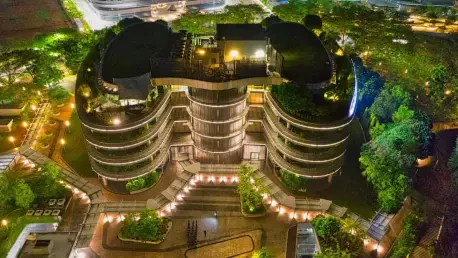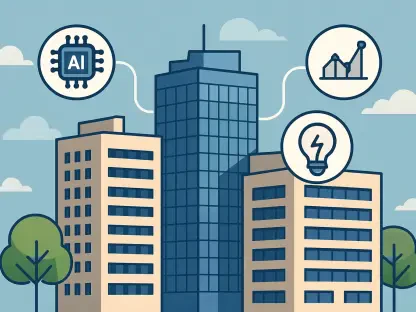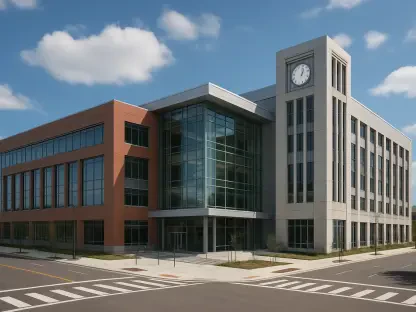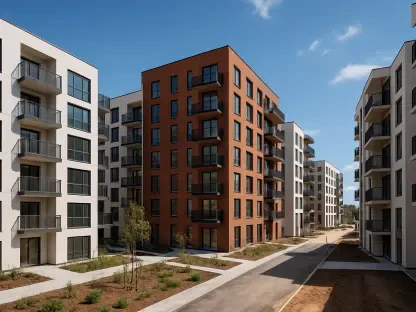Amid unfolding environmental challenges and intensifying calls for sustainable development, China stands at the forefront of a green revolution in its building practices. This movement has gathered significant momentum as the nation embraces sustainable architecture, driven by a robust implementation of the Leadership in Energy and Environmental Design (LEED) standards. With LEED certification serving as a benchmark, China’s green building sector has witnessed remarkable growth, becoming a pivotal part of the country’s commitment to minimizing its carbon footprint. The rapid evolution of consumer awareness towards eco-friendly living has catalyzed this transformation, propelling companies and developers to innovate ways to integrate sustainable designs into their projects. This comprehensive shift not only aligns with national environmental goals but also reflects a global trend of elevating eco-consciousness to the forefront of urban planning.
The Rise of Green Building in China
Factors Driving Sustainable Building Practices
In recent years, China has made substantial strides in sustainable construction as a response to the global call for environmentally responsible building practices. The integration of Environmental, Social, and Governance (ESG) principles has been central to this progress, influencing construction guidelines and encouraging developers to adopt greener alternatives. This adaptation has been facilitated by China’s ambitious dual-carbon goals, mandating a move towards carbon neutrality and a significant reduction in carbon emissions within this decade. As these regulatory standards evolved, businesses have found themselves compelled to align with the expectations of a changing global marketplace that prioritizes sustainability over traditional approaches. This alignment is not merely a legal obligation but increasingly occurs due to burgeoning consumer demand.
Young consumers in particular are emerging as significant change-makers in this domain. With an ever-growing preference for low-carbon lifestyles, this demographic is driving a cultural shift towards eco-friendlier living spaces. Their choices reflect a broader societal transition where the environmental impact of residential and commercial spaces is prioritized, influencing real estate developments and fostering worthier market valuations for properties that boast energy-efficient credentials. This consumer shift underscores a collective desire for spaces that not only meet the functional demands of modern living but also contribute positively to the planet’s health. Consequently, real estate developers are incorporating sustainability into the very DNA of their designs, seizing the opportunity to develop infrastructures that cater to an eco-conscious populace.
Role of LEED Certification in Green Building
The influence of LEED certification cannot be overstated in the green building sector. Having gained a reputation as a prestigious hallmark of sustainable and resource-efficient building practices, it fosters a culture of continuous improvement in construction methodologies. The LEED framework provides a comprehensive approach for certifying buildings based on their energy performance, indoor air quality, water conservation, and overall environmental impact. By setting clear metrics and performance benchmarks, LEED effectively guides architects and builders towards achieving higher standards of sustainable development.
As a catalyst for sustainable construction, LEED has witnessed prolific adoption across various Chinese sectors. The healthcare industry serves as a prime example of integrating green standards, with LEED Zero Energy buildings exemplifying advances in creating energy-efficient and health-focused environments. Equally committed, the food and beverage sector has transformed its service environments to meet LEED criteria, demonstrating corporate accountability by enhancing operational efficiency and sustainability. Logistics enterprises, too, notably embrace LEED principles, innovating to achieve elusive green goals. This surge in LEED-certified projects is indicative of a paradigm shift, where the adherence to such sustainable frameworks positions China as a leader in the global green building landscape.
Industry Innovation: Beyond Traditional Construction
Green Adoption Across Key Sectors
Industries across China have increasingly adopted green building practices, each striving for certification to align operations with modern environmental standards. In healthcare, companies like Cowell Health have innovatively crafted facilities that meet LEED Zero Energy standards, ensuring their spaces promote energy efficiency and human health. By developing environmentally sensitive spaces, the healthcare industry not only reduces its carbon footprint but also enhances patient well-being through improved indoor environmental quality. The food and beverage sector has also seen substantial investment in green design. McDonald’s and Luckin Coffee, for instance, have undertaken significant retrofitting of outlets to align with LEED certifications. These efforts are focused on reducing energy use and improving operational sustainability while maintaining brand appeal.
Meanwhile, logistics actors such as Mapletree Investments have revolutionized warehouse design. By incorporating architectural elements aimed at reducing energy consumption and operational costs, these firms lower emissions and enhance logistical efficiency. Green building practices across these diverse sectors demonstrate an evolution in corporate strategy, viewing sustainability not just as a regulatory requirement but as a source of competitive advantage. This evolution further reflects an industry consensus where environmental responsibility is a core tenet of successful business operations, prompting organizations to embed green standards into every facet of their frameworks.
Expanding the Scope of Sustainable Design
China’s expansive commitment to sustainable building practices continues to push boundaries, extending beyond traditional construction methodologies. Among tier-one cities like Shanghai, Guangzhou, and Shenzhen, developers consistently prioritize LEED standards in high-rise complexes, setting new industry benchmarks. However, this trend is not limited to metropolitan epicenters. Emerging markets within Jiangsu and Zhejiang provinces illustrate an equally profound zeal for sustainable architecture, embracing design principles that emphasize decarbonization and ecological conservation. This extended focus across regions epitomizes a nationwide embrace of sustainability, wherein even smaller urban centers seek to nurture green developments as integral frameworks in their urban strategies.
Moreover, the adoption of cutting-edge technologies like energy modeling software and smart building systems reinforces China’s vision of sustainable urban planning. These technologies facilitate a level of precision in the design and execution phases, optimizing energy use and driving cost efficiencies in building maintenance. As the sector matures, the blend of smart technologies with global green standards spotlights China’s adaptability in pursuing innovative approaches to sustainability. This convergence presents substantial opportunities not only for environmental resilience but also for economic growth, as efficiently managed properties appreciate at a higher rate, attracting both residents and investors alike.
The Future of Green Building in China
Towards Greater Environmental Responsibility
As the green building movement continues to gain traction, China’s commitment to sustainability is poised for further enhancement. The implementation of new regulatory standards and updated versions of certification systems such as LEED v5 underscores this commitment, setting ambitious future targets focused on decarbonization and quality of life improvements. These new standards provide a framework that adjusts to emerging environmental challenges, encouraging industries to elevate their sustainability efforts to unprecedented levels. The regulatory landscape is conducive to fostering innovation, compelling businesses to align with higher ecological goals that transcend mere obligation.
Future trajectories of green building practices indicate an increasingly rigorous approach to resource management and conservation. By exceeding basic adherence to environmental regulations, industries are anticipated to explore new frontiers in sustainability, prioritizing intelligent design and energy innovation. Additionally, these trends suggest a broader societal consensus towards nurturing resilient, adaptable communities that encourage environmentally conscious living. This evolving approach will likely lead to more industries pledging commitments to sustainable practices, thus strengthening China’s trajectory towards a low-carbon future.
Global Leadership in Sustainable Development
China’s consistency in pursuing sustainable development reaffirms its position as a global trailblazer in green architecture. By driving momentum through a fusion of regulatory advancements, consumer demand, and corporate initiatives, the nation has firmly established itself as a leading figure in sustainable building design. This leadership is particularly underscored by China’s dominance in LEED certification, marking an impressive track record in promoting eco-friendly standards on an international stage. The confluence of these elements not only elevates China’s domestic standing but also influences global perceptions and practices regarding sustainable infrastructure.
As the nation continues to progress on its dual-carbon journey, China’s achievements in green construction present actionable blueprints for other countries seeking to replicate its success. The country’s holistic approach, prioritizing both environmental and social benefits, bridges the gap between abstract policy goals and tangible outcomes, illustrating the potential of collective national effort. These aspirations underscore the transformative power of green building initiatives, guiding both policymakers and industry leaders towards a more sustainable, ecosystem-attuned future. By integrating best practices and leveraging its vast resources, China paves the way for enduring sustainable advancements that inspire wider global action.
Transforming the Urban Landscape with Green Initiatives
In recent years, China has significantly advanced in sustainable construction, responding to the global need for environmentally responsible building methods. Central to this advancement is the integration of Environmental, Social, and Governance (ESG) principles into construction guidelines, which encourages developers to pursue greener alternatives. Support has come from China’s ambitious dual-carbon objectives, which aim for carbon neutrality and a substantial decrease in emissions over the next decade. As regulations have become more strict, businesses must align with an evolving global market that prioritizes sustainability over traditional practices. This shift isn’t just due to legal requirements but is increasingly driven by consumer demand.
Young consumers, in particular, play an essential role in this transformation. With a growing inclination for low-carbon lifestyles, they are leading a cultural shift towards eco-friendlier living spaces. Their preferences highlight a societal transition valuing the environmental impact of residential and commercial properties. This consumer shift is prompting real estate developers to integrate sustainability into their designs, creating infrastructure that meets modern needs and supports environmental health.









